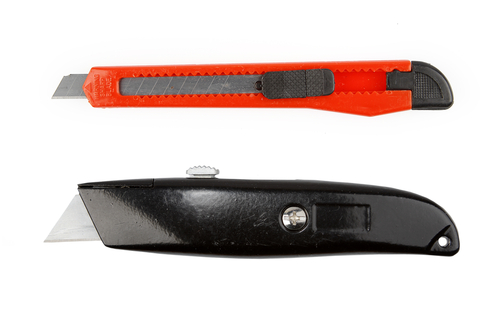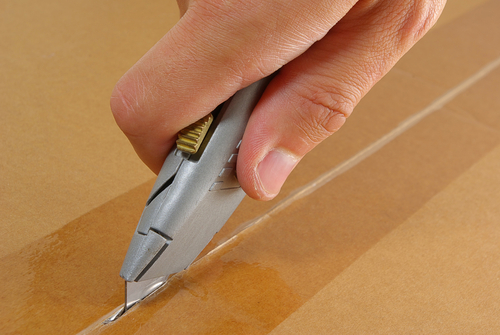These blades are designed for heavy-duty work, and that work dulls a blade sooner rather than later. Thus, most utility knives feature disposable blades that can be changed out to get a sharp, fresh edge. Although they require less maintenance than traditional knives that need frequent sharpening, these tools still need upkeep to offer their best performance.
Let’s look at a few key tips for the use and maintenance of box cutter blades. This knowledge base will help you and your employees get the most out of your utility knives. We’ll examine common types of box cutters, when you should replace a blade and a simple process for swapping out an old blade for a new one.
Two Main Types of Box Cutter Blades
Two types of box cutter blades are commonly available on the market today: the more traditional trapezoidal blade and the newer snap-off blade.
- A trapezoidal blade is a classic design that’s been used in utility knives for decades. It’s long on one end and short on the other, with a precision-cut razor edge on the long side and a cutting point on either end. The double-tipped design means that it can be turned around when a fresh blade is needed.
- Snap-off blades are a newer invention that quickly gained popularity on job sites around the world. A snap-off blade is one long blade, manufactured with seams in it that create a “new” blade when snapped off with a pair of pliers. These blades often don’t last as long as trapezoidal blades, but when replacement is a simple matter of snapping off a piece of metal with pliers, it’s usually not a concern.

The two types of box cutters: snap-off blades (top) and trapezoidal blades (bottom).
Whichever kind of blades you’re using in your utility knives, you’ll need to replace them eventually. If you notice any of the following signs, it’s probably time for a replacement.
1. Rust.
Due to their disposable nature, utility knife blades often rust much more quickly than blades on a regular knife. If you’ve had a blade in a knife long enough for it to be rusting, it’s definitely time to change it out.
2. Problems extending and retracting the blade.
These could point to issues with the structure of the knife itself, so make sure it’s not damaged or jammed with some kind of debris. However, it’s also possible that damage to the blade is preventing it from operating properly. Very dirty or rusty blades often cause these problems.
3. A blade that becomes ragged or stays dull after sharpening.
If you’re using a knife with a snap-off blade, don’t even bother sharpening it. These blades are designed to be thrown away after use, not sharpened. Just snap the segment off to get a new edge.
However, if you’re using traditional trapezoid blades, you might be sharpening them to conserve blades and save money. While this can work for a while, the quality of the metal in these blades is not the same as what you’d get in a regular pocket knife. Eventually, the metal will degrade enough that sharpening will produce either a persistently dull blade or, worse, a ragged blade that produces jagged, unsafe cuts. These blades are designed to be disposable, so don’t be afraid to reach for a replacement.
How to Replace a Utility Knife Blade
Replacing a utility knife blade is, by design, a simple process. Here’s how to do it in four easy steps:
- Open the knife. For trapezoidal blades, you’ll usually have to take the knife apart by removing the screw that holds it together. With a snap-off blade, you might be able to skip this step.
- Find the component that holds the blade in. On a traditional knife, this will be a blade housing near the top of the knife that slides back and forth. Remove the housing, then the blade. For a snap-off blade, this will probably be a small button that holds the blade in place on the running track — press this button, then slide the blade out of the track.
- Replace the blade in the housing. Each knife is slightly different, so you’ll need to pay attention to how the blade fits the housing and how the housing fits the knife. Place the housing back into the knife.
- Close the knife, using the same procedure as Step One but in reverse.

A box cutter knife is a tool that has the power to make life easier for everyone in your warehouse. Make sure you’re taking good care of these tools by keeping them supplied with fresh, sharp blades. If you do, you can count on safe and productive operation when you need it the most.











